Impressions from Colours of Ostrava, Ostrava, Czech Republic, 17-20 July 2014
1. 8. 2014 | Rubriky: Articles,Feature
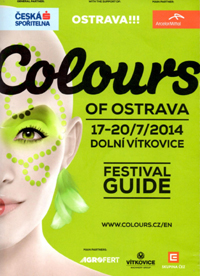
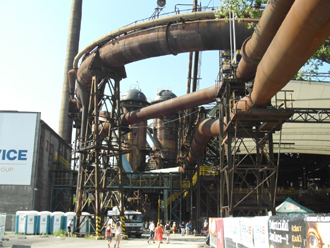 [by Ken Hunt, Ostrava, Vienna and London] A fortnight before the yearly festival happened, The Prague Post informed readers that Colours of Ostrava was “the Czech Republic’s top summer music event”. Impressions from attending the festival serve to confirm that indisputably it is. Ostrava is in the top right of the country. Poland is 15 km away and the Slovak Republic 55 km distant. Inevitably therefore it is a festival that attracts an international audience. Ten years after the festival’s founding, that is, in 2012 this “multi-genre music festival” switched locations across the city. Since then has taken place in Ostrava’s Vítkovice district. Its new setting is one of preserved industrial ‘dereliction’ – aka a UNESCO heritage site. And to mangle the Four Seasons’ comeback hit, ‘Oh, what a site!’
[by Ken Hunt, Ostrava, Vienna and London] A fortnight before the yearly festival happened, The Prague Post informed readers that Colours of Ostrava was “the Czech Republic’s top summer music event”. Impressions from attending the festival serve to confirm that indisputably it is. Ostrava is in the top right of the country. Poland is 15 km away and the Slovak Republic 55 km distant. Inevitably therefore it is a festival that attracts an international audience. Ten years after the festival’s founding, that is, in 2012 this “multi-genre music festival” switched locations across the city. Since then has taken place in Ostrava’s Vítkovice district. Its new setting is one of preserved industrial ‘dereliction’ – aka a UNESCO heritage site. And to mangle the Four Seasons’ comeback hit, ‘Oh, what a site!’
My first impressions of the site with no festival crowd inside it were mixed. A real ‘What the fuck!’ deal. Treat that fruity remark in the sense of judging a book by its cover. Even from the outside its industrial landscape is imposing but its architecture gives little away about the sheer scale and size of what is behind the site’s fences and outer rim of buildings. Within the festival grounds is a Metropolis set (think Fritz Lang) seemingly for the Twentieth Century more than the Twenty-first Century. It is made of steel, rust, pipes, chimneys, towers, more rust, greenery growing in walkways eight meters above our heads and, a favourite, a gasometer converted into a conference centre with venue (Colours’ Vítkovice Gong Stage). Initially orientation appeared impossible. Gradually dots joined up. But given the size of the site, musical inclinations, temperatures in the high 30s and musical curiosity, there were corners of the festival grounds upon which Kenneth never clapped eyes. Two shallow excuses would be I wound up doing a couple of, for me, interesting conversations with musicians before audiences of a few hundred festival-goers on the Gong Reflex Stag. Mine were with Iceland’s Emilíana Torrini and a Welsh group called 9Bach to which the singer-songwriter Bonnie Dobson had drawn my attention before their signing to Real World and making their second album Tincian. In part, another excuse for not seeing acts was also down to the English-language festival programme being shakier about Czech and Slovak acts than its Czech-language edition, though I may be doing that programme a disservice as I failed to pick up a copy.
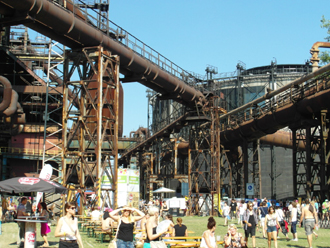 Some festival-goers choose to fly around a festival sampling as much nectar from as many flowers as possible. As it were, the catch-a-few-songs-here and the half-a-set-there approach. My approach is to catch entire sets in order to get a bigger picture. It’s not necessarily better, just a different approach, but it suits me and my legs and my head better. Years of experience of TFF Rudolstadt’s multi-stage character – and mountain-goating it there – have counselled me in this more leisurely, more intense approach. One unmissable act had to be Lo Còr De La Plana, one of France’s greatest folk-flavoured bands. They come from the People’s Republic of Marselha, elsewhere known as Marseilles. They are a male sextet and combine polyphony and percussion. That Saturday evening on the Drive Stage, in the time they performed they were without question the best band on the planet. They exceeded themselves and initiated a set of ring dances that swept through the tented venue. Social dance was not something I was expecting at Colours of Ostrava and nor would I have expected to join in. However, it would have been churlish not to join in. Handsome men and beautiful women held out hands to strangers and whisked the next stranger into the ring dance.
Some festival-goers choose to fly around a festival sampling as much nectar from as many flowers as possible. As it were, the catch-a-few-songs-here and the half-a-set-there approach. My approach is to catch entire sets in order to get a bigger picture. It’s not necessarily better, just a different approach, but it suits me and my legs and my head better. Years of experience of TFF Rudolstadt’s multi-stage character – and mountain-goating it there – have counselled me in this more leisurely, more intense approach. One unmissable act had to be Lo Còr De La Plana, one of France’s greatest folk-flavoured bands. They come from the People’s Republic of Marselha, elsewhere known as Marseilles. They are a male sextet and combine polyphony and percussion. That Saturday evening on the Drive Stage, in the time they performed they were without question the best band on the planet. They exceeded themselves and initiated a set of ring dances that swept through the tented venue. Social dance was not something I was expecting at Colours of Ostrava and nor would I have expected to join in. However, it would have been churlish not to join in. Handsome men and beautiful women held out hands to strangers and whisked the next stranger into the ring dance.
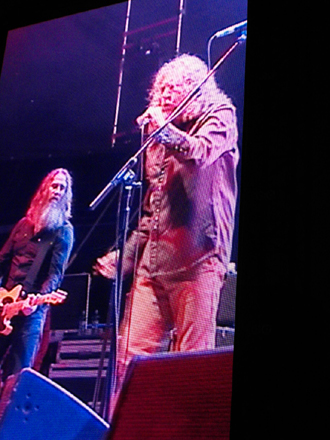 At concert’s end, Lo Còr De La Plana announced their next day’s collaboration with the Naples-based female quartet Assurd. It was hymned as Vé Zou Via (that is, a pun on Vesuvius) and it
At concert’s end, Lo Còr De La Plana announced their next day’s collaboration with the Naples-based female quartet Assurd. It was hymned as Vé Zou Via (that is, a pun on Vesuvius) and it
would have been rude to decline the invitation. The next afternoon they sang like the choir on Olympus. Stupid me, I was so carried away by their vocal swell that when the amplification and lighting dropped out and they sang unamplified I fancied it was part the Vé Zou Via act. Hey, without getting fazed or skipping a beat, nine musicians went acoustic, peered into the packed tent in front of them and continued singing their hearts out. The electricity returned at some point and they resumed their electric set. Seldom has electrifying professionalism seemed so unaffected and natural.
Sunday’s other, earlier highlight was 9Bach. They are doing things for Welsh music that are revelatory and live they proved themselves to be a world-class folk-themed band. Returning to the hotel late that evening, a gentleman got off the same tram and rushed up to me. He engaged me energetically, saying he had gone along to the 9Bach conversation on spec that morning, not knowing a thing about Wales or Welsh music, let alone 9Bach. I had asked Lisa Jên to sing a Welsh folksong unaccompanied as part of the talk and she sang deliciously. The stranger had enjoyed her singing so much and his curiosity was so piqued by the discussion that he went to the concert. For him and me alike, 9Bach’s performance on the Gong Vítkovice Stage was one of Colours’ ear-openers. With that he rushed off in the opposite direction. The exchange lasted little more than two minutes but, for me, it reaffirmed what festivals can do in allowing acts to talk to festival-goers.
I have jumped ahead a day. Looming over the festival was Saturday night’s Ostrava return for Robert Plant and The Sensational Space Shifters on the Česká Spořitelna Stage. They did not disappoint. Even though their lullaby and… THE CEASELESS ROAR was as yet unreleased, they were holding a hand of trumps since Plant needs no education when it comes to constructing a set. Plus he can rely on choice morsels from the Led Zeppelin hostess trolley. Plant is savvy enough to juggle old and new material to please and tease. They did the upcoming album’s Little Maggie and Rainbow. They revealed them to be new tours-de-force in waiting. Looking backwards, Whole Lotta Love – which also skirted Quicksilver Messenger Service’s take of Bo Diddley’s Who Do You Love? – was pure deliciousness. The set revealed aspects of the band’s essence with psychedelia, some world music and a wholesome serving of rock.
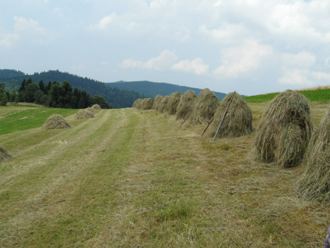 For me, two extra-musical strands added credence to the line about Colours of Ostrava being “the Czech Republic’s top summer music event”. I’ll give credit to the festival’s director, Zlata Holušová.
For me, two extra-musical strands added credence to the line about Colours of Ostrava being “the Czech Republic’s top summer music event”. I’ll give credit to the festival’s director, Zlata Holušová.
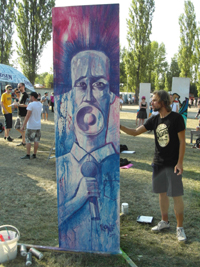 In order to arrive in good time for a front-row position for Lo Còr De La Plana, I wandered well ahead of time across the site to get a beer and write at a table in the nearby beer tent. Close to the Drive Stage where they were appearing, there was a whole crew of graphic artists – street, graffiti or otherwise – creating festival-temporary works of art. They were ‘under construction’. Over the course of the festival I returned to see how they had progressed. I have no notion of the names of who did what but the vibrancy and excitement of their art impressed – that and the decision to include it as a feature. Here’s hoping it is a regular occurrence.
In order to arrive in good time for a front-row position for Lo Còr De La Plana, I wandered well ahead of time across the site to get a beer and write at a table in the nearby beer tent. Close to the Drive Stage where they were appearing, there was a whole crew of graphic artists – street, graffiti or otherwise – creating festival-temporary works of art. They were ‘under construction’. Over the course of the festival I returned to see how they had progressed. I have no notion of the names of who did what but the vibrancy and excitement of their art impressed – that and the decision to include it as a feature. Here’s hoping it is a regular occurrence.
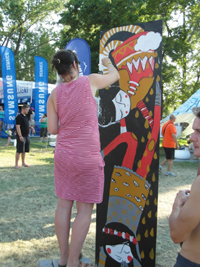 The most subtle, unobtrusive and mysterious non-musical element was a post-revelry one. Saturday’s headlining act happened on the Česká spořitelna stage. After Robert Plant and the Sensational Space Shifters finished their set, the audience dispersed. (Basille were coming on 90 minutes later after midnight.) Above the mixing tower facing the stage, the sound of clock chimes rang out – ones of the kind that chime the quarters but, more specifically the fourth quarter. Public clocks do it all across Europe. Perhaps, the Czech Republic’s most famous one is the astronomical clock in Prague’s Staroměstské náměstí. In the ‘Old Town Square’ you have The Walk of the Apostles and sundry fixed figures doing particular things as the quarters sound. It makes for spectacle. Go past it enough times and the experience gets diminished, dimmed or downgraded. It’s like a Londoner hearing the Cambridge Quarters struck by ‘Big Ben’ yet another time.
The most subtle, unobtrusive and mysterious non-musical element was a post-revelry one. Saturday’s headlining act happened on the Česká spořitelna stage. After Robert Plant and the Sensational Space Shifters finished their set, the audience dispersed. (Basille were coming on 90 minutes later after midnight.) Above the mixing tower facing the stage, the sound of clock chimes rang out – ones of the kind that chime the quarters but, more specifically the fourth quarter. Public clocks do it all across Europe. Perhaps, the Czech Republic’s most famous one is the astronomical clock in Prague’s Staroměstské náměstí. In the ‘Old Town Square’ you have The Walk of the Apostles and sundry fixed figures doing particular things as the quarters sound. It makes for spectacle. Go past it enough times and the experience gets diminished, dimmed or downgraded. It’s like a Londoner hearing the Cambridge Quarters struck by ‘Big Ben’ yet another time.
After Robert Plant and the Sensational Space Shifters had done their bestest, the glory that Colours of Ostrava had put on and Cia La Tal’s Carillo had created was probably missed by a good chunk of the audience exiting that field of dreams. You had to be in the right place and right frame of mind to experience what the tower was producing. Bożena Szota, the festival director of Ethno Port Poznań in Poland and I gazed up in a state of wonderment. The penny dropped when realising that it wasn’t mechanical figures but human mannequins now putting on a further, visual show. On several levels I bet it went over many people’s heads. We stood there absorbed.
Colours of Ostrava is like no music festival I have ever experienced anywhere in Europe.
Further information about Colours of Ostrava is at: http://www.colours.cz/en/
Further information about Cia La Tal | Compañía de Teatro Internacional in English, Spanish and Catalan is at: http://cialatal.com/>
All photographs © Ken Hunt/Swing 51 Archives. The hay stooks are from a trip into the Carpathians with Grit Friedrich, Ben Mandelson, Jiři Plocek and Benjamin Taubkin to visit the extraordinary instrument maker Vít Kašpařík in Velké Karlovice. But that’s a story for another time.